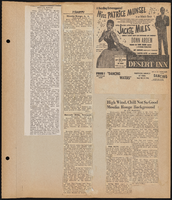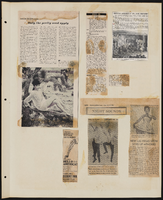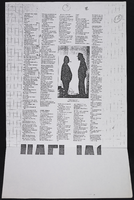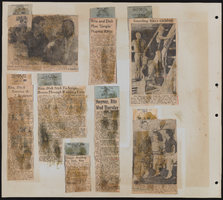Search the Special Collections and Archives Portal
Search Results
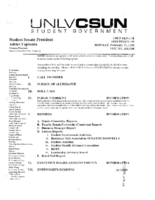
Meeting minutes for Consolidated Student Senate, University of Nevada, Las Vegas, February 27, 2006
Date
2006-02-27
Archival Collection
Description
Includes meeting agenda and minutes, along with additional information about senate bills.
Text
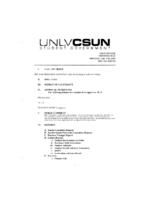
Meeting minutes for Consolidated Student Senate, University of Nevada, Las Vegas, July 11, 2005
Date
2005-07-11
Archival Collection
Description
Includes meeting minutes and agenda, along with additional information about contracts and performance agreements.
Text
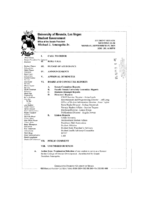
Meeting minutes for Consolidated Student Senate, University of Nevada, Las Vegas, September 15, 2003
Date
2003-09-15
Archival Collection
Description
Includes meeting minutes and agenda, along with additional information about letters and contracts.
Text
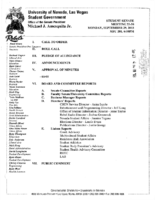
Meeting minutes for Consolidated Student Senate, University of Nevada, Las Vegas, September 29, 2003
Date
2003-09-29
Archival Collection
Description
Includes meeting agenda, along with additional information about operating policies, bylaws, and contracts.
Text

Inspire Theater Neon Survey document, August 18, 2017
Date
2017-08-18
Archival Collection
Description
Information about the Inspire Theater sign that sits at 107 S Las Vegas Blvd.
Site address: 107 S Las Vegas Blvd
Sign owner: Fremont LV Blvd LLC
Sign details: The original construction year of the building dates back to 1952. Though in 2013 the building was redesigned to open as the Inspire theater in 2014. The Inspire Theater offers a variety of venues including a 150 seated theater, a rooftop patio and multiple cocktail bars.
Sign condition: 5 - new sign with good quality day and night
Sign form: Blade and semi-decorated shed
Sign-specific description: The sign itself is all connected though it wraps around the whole building, it starts with a long rectangular blade with their logo then goes in a rectangle around the building and ends with their logo on a shorter blade with their logo. The longer white rectangular blade portion begins on the corner of the building above their rooftop lounge (which meets together back to back with a smaller rectangular blade). If you are going north on Las Vegas Blvd you will see the big blade which reads "INSPIRE" in channeled silver thin print font letters. The adjacent blade is a bit shorter, so you can see a portion of the big blade over the smaller one if you are looking at the building from the East Fremont District, with this overlay it looks like there is a letter "I" and a dash(-) underneath it. On the actual portion of the shorter blade there are the "INSPIRE" thin channeled font letters, which are identical in design to the other side of the sign but just a smaller font. The outside edges of these back-back signs are horizontally lined with neon tubing. These blades then continue around the building into two horizontally neon lined strips that make the building have a decorated shed feature to it. This then makes a rectangular feature around the whole building. In between the top of the rectangle and the bottom, there is a balcony where guests can hang out. Though on both the left and the right sides of the blade there are plasma screens that show advertisements for their property. Also on the west side of the building there are thin horizontal strips of LED/plasma lights that sparkle in an iridescent fashion.
Sign - type of display: Neon
Sign - media: Steel
Sign - non-neon treatments: T.V. screens, LED
Sign animation: Flasher and iridescent light flow
Sign environment: On the corner of South Las Vegas Blvd. and Fremont St. East, the first property on the south side of the Fremont St East District.
Sign - date of installation: 2014
Sign - thematic influences: The sign is incorporated into the architecture, as well as the sign wraps around the entire building which is remnant of the decorated shed look. The sign is related to the theater theme since the blade style sign was very prominent for the 1950's and 60's movie theater signs, such as the El Portal movie theater sign.
Sign - artistic significance: Their sign is very remnant of a 1950's Movie theater sign with the blade and wrap around of Neon, since they are a modern day theater it seems as if it's a retro throwback.
Survey - research locations: Inspire website, assessor's website
Surveyor: Emily Fellmer
Survey - date completed: 2017-08-18
Sign keywords: Blade; Neon; Steel; LED; Flashing; Video screen
Site address: 107 S Las Vegas Blvd
Sign owner: Fremont LV Blvd LLC
Sign details: The original construction year of the building dates back to 1952. Though in 2013 the building was redesigned to open as the Inspire theater in 2014. The Inspire Theater offers a variety of venues including a 150 seated theater, a rooftop patio and multiple cocktail bars.
Sign condition: 5 - new sign with good quality day and night
Sign form: Blade and semi-decorated shed
Sign-specific description: The sign itself is all connected though it wraps around the whole building, it starts with a long rectangular blade with their logo then goes in a rectangle around the building and ends with their logo on a shorter blade with their logo. The longer white rectangular blade portion begins on the corner of the building above their rooftop lounge (which meets together back to back with a smaller rectangular blade). If you are going north on Las Vegas Blvd you will see the big blade which reads "INSPIRE" in channeled silver thin print font letters. The adjacent blade is a bit shorter, so you can see a portion of the big blade over the smaller one if you are looking at the building from the East Fremont District, with this overlay it looks like there is a letter "I" and a dash(-) underneath it. On the actual portion of the shorter blade there are the "INSPIRE" thin channeled font letters, which are identical in design to the other side of the sign but just a smaller font. The outside edges of these back-back signs are horizontally lined with neon tubing. These blades then continue around the building into two horizontally neon lined strips that make the building have a decorated shed feature to it. This then makes a rectangular feature around the whole building. In between the top of the rectangle and the bottom, there is a balcony where guests can hang out. Though on both the left and the right sides of the blade there are plasma screens that show advertisements for their property. Also on the west side of the building there are thin horizontal strips of LED/plasma lights that sparkle in an iridescent fashion.
Sign - type of display: Neon
Sign - media: Steel
Sign - non-neon treatments: T.V. screens, LED
Sign animation: Flasher and iridescent light flow
Sign environment: On the corner of South Las Vegas Blvd. and Fremont St. East, the first property on the south side of the Fremont St East District.
Sign - date of installation: 2014
Sign - thematic influences: The sign is incorporated into the architecture, as well as the sign wraps around the entire building which is remnant of the decorated shed look. The sign is related to the theater theme since the blade style sign was very prominent for the 1950's and 60's movie theater signs, such as the El Portal movie theater sign.
Sign - artistic significance: Their sign is very remnant of a 1950's Movie theater sign with the blade and wrap around of Neon, since they are a modern day theater it seems as if it's a retro throwback.
Survey - research locations: Inspire website, assessor's website
Surveyor: Emily Fellmer
Survey - date completed: 2017-08-18
Sign keywords: Blade; Neon; Steel; LED; Flashing; Video screen
Text
Pagination
Refine my results
Content Type
Creator or Contributor
Subject
Archival Collection
Digital Project
Resource Type
Year
Material Type
Place
Language
Records Classification

